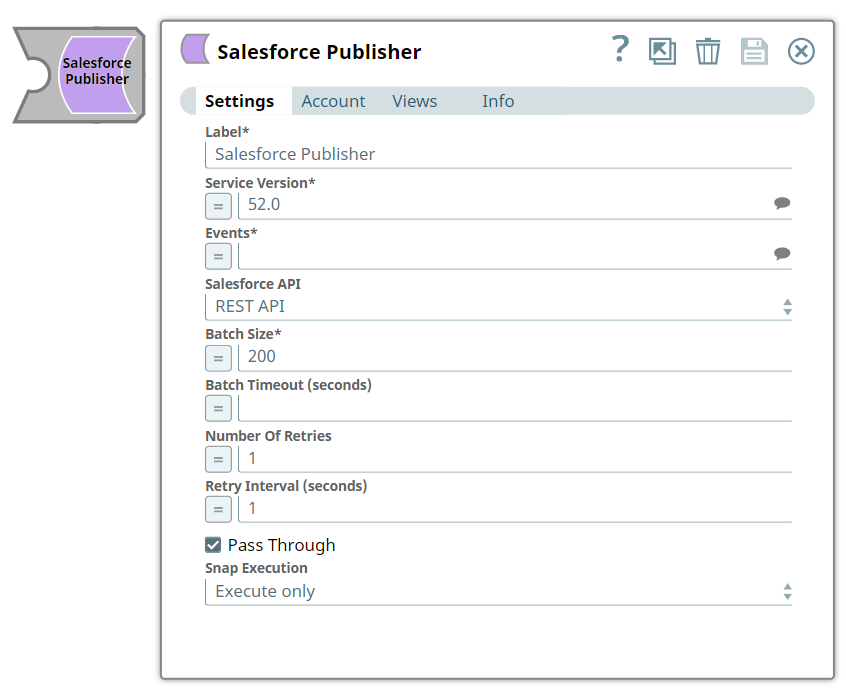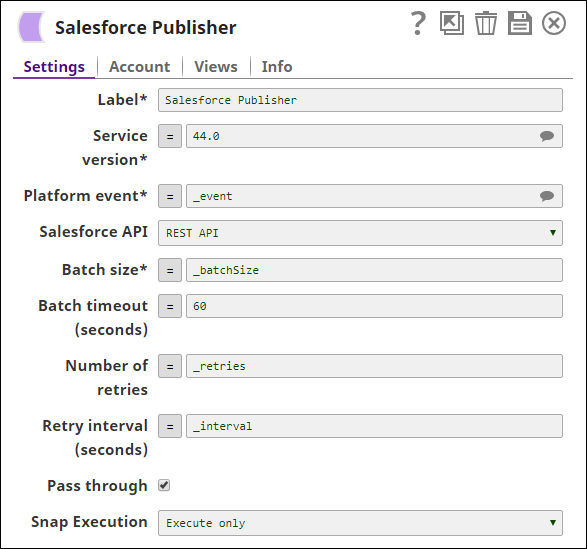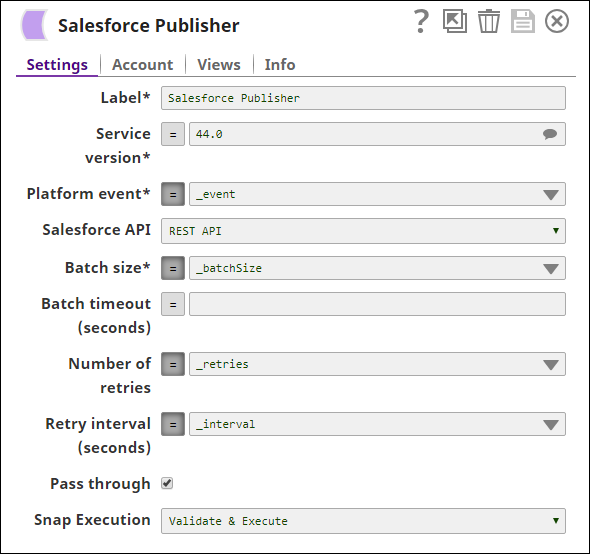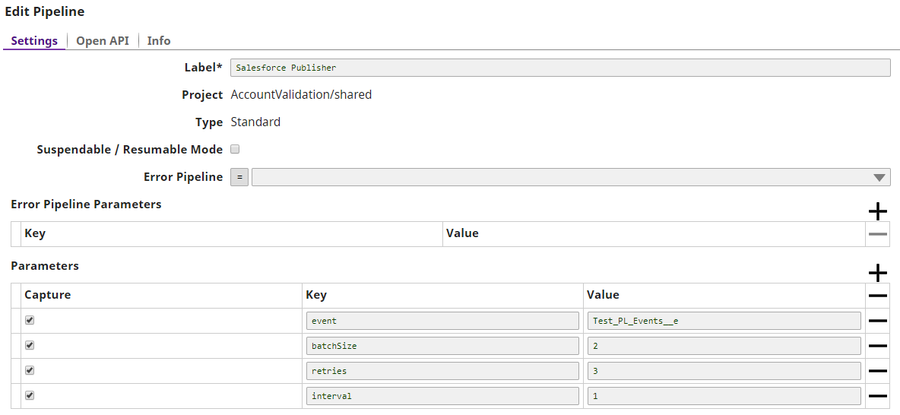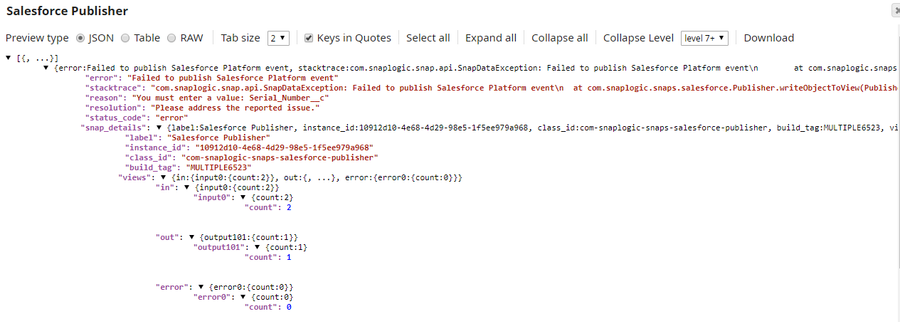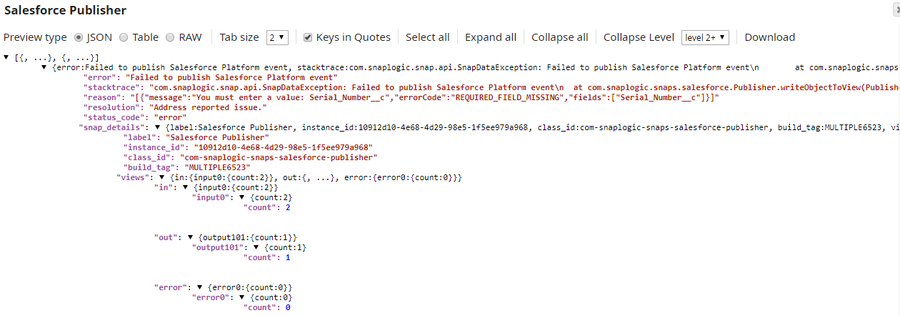On this Page
| Table of Contents | ||||
|---|---|---|---|---|
|
Overview
The Salesforce Publisher Snap is a Write-type Snap that publishes Salesforce platform event Platform Event records to a given event custom sObject ( Salesforce Object)object. Salesforce platform eventsPlatform Events are part of Salesforce’s enterprise messaging platform and help deliver secure and scalable custom notifications within Salesforce or from external sources.
In Bulk API mode, the Snap publishes multiple platform event records in batches.
In REST API mode, the Snap publishes only one platform event record per each request , for each input document.
| Note | ||||||||||||
|---|---|---|---|---|---|---|---|---|---|---|---|---|
|
| Info |
|---|
Refer the Salesforce Platform Event Allocations document before configuring this Snap. |
Input and Output
Expected input:Prerequisites
None.
Limitations and Known Issues
- In Salesforce 44.0, when an input document contains extra fields which are not part of the list of fields defined in a given Platform Event object, the error handling of Salesforce.com in REST API and Bulk API is different. REST API throws the error: "No such column ...". However, Bulk API ignores all extra fields and successfully publishes records as long as the mandatory fields are present.
- This Snap performs batch processing, that is, a batch of input documents are processed for each HTTP request sent to Salesforce. Values of all the expression-enabled fields must remain constant during the Snap execution or validation. Hence, all expression fields can support Pipeline parameters only when they are expression-enabled. The input data parameters are not supported for expression fields, for example, $serviceVersion
Support for Ultra Pipelines
Works in Ultra Pipelines.
Snap Views
| Type | Format | Number of Views | Examples of Upstream and Downstream Snaps | Description |
|---|---|---|---|---|
| Input | Document | Min: 1 Max: 1 |
| A stream of documents whose data schema is the same as the schema that is defined in the selected Platform Event custom |
| Salesforce object. Each document contains one Salesforce Platform Event record. The Snap supports the input schema suggest functionality that shows the input schema in the Target path of the Mapper Snap if the Mapper Snap is connected to the input view. |
| Output | Document | Min: 0 Max: 1 |
| A stream of documents that contain the success field for the event record that is published, and the original field for the corresponding input record |
Expected upstream Snaps: Any Snap with a document output view. For example, JSON Parser, Mapper.
Expected downstream Snaps: Any Snap with a document input view. For example, JSON Formatter, Mapper.
Prerequisites
None
Configuring Accounts
This Snap uses account references created on the Accounts page of SnapLogic Manager to handle access to this endpoint. See Salesforce Account for information on setting up this type of account| . |
Configuring Views
This Snap has exactly one input view. | |
| Output | This Snap has at most one output view. |
|---|---|
| Error | This Snap has at most one error view and produces documents in the view. Each document in the error view contains key/value pairs from the input view and an error message from Salesforce.com. The error message is in the value of the error key. |
Troubleshooting
None
Limitations and Known Issues
In Salesforce 44.0, when an input document contains extra fields which are not part of the list of fields defined in a given Platform Event object, the error handling of Salesforce.com in REST API and Bulk API is different. REST API throws the error: "No such column ...". However, Bulk API ignores all extra fields and successfully publishes records as long as the mandatory fields are present.
Modes
- Ultra pipelines: Works in Ultra pipelines.
- Spark mode: Does not work in Spark mode.
Snap Settings
| Label | Required. TheError | The error view contains error, reason, resolution and stack trace. For more information, see Handling Errors with an Error Pipeline. | |||
|---|---|---|---|---|---|
Snap Settings
| Field | Field Type | Description | ||||||||
|---|---|---|---|---|---|---|---|---|---|---|
| Label* | String | Specify the name for the Snap. You can modify this to be more specific, especially if you have more than one of the same Snap in your pipelinePipeline. | Service version | Required. The versionDefault Value: Salesforce Publisher | ||||||
| Service Version* | String | Required. T Specify the version number of the Salesforce service that you want to connect to.
ExampleDefault Value: 44.00 | Platform event | 0 | ||||||
| Events* | String | Specify the name of the Salesforce platform event custom object. __e. You can select the name from the suggested list in the Example: Printer_Event__e Default value: None | Salesforce API | The Salesforce API mode. Select either Bulk API or REST API. drop-down menu. The supported Salesforce Events are:
Default Value: None | ||||||
| Salesforce API | Dropdown list | Select the Salesforce API mode. The available options are:
Default Value: REST API Example: Bulk API | ||||||||
| Batch sizeRequired. The | Integer | Specify the batch size in records.
Default Value: 200 | ||||||||
| Batch timeout | The (seconds) | Integer | Specify the batch timeout in seconds. The Snap sends a batch write request to SDFC when the number of input documents in the buffer reaches the given Batch size. However, sometimes, input documents may not arrive for a long time. In such cases, a Batch timeout value helps send a batch write request in a specified time interval even if the number of input documents in the buffer is less than the buffer size. If you set Batch timeout to 0, the Snap waits until the number of input documents in the buffer reaches the Batch size. Default Value: None | |||||||
| Number of retriesThe | Integer | Specify the maximum number of retry attempts in case of a network failure. Default value: 1 Ensure that the local drive has sufficient free disk space to store the temporary local file. | ||||||||
| Retry interval (seconds) | Integer | The Specify the minimum number of seconds for which the Snap must wait before attempting recovery from a network failure. ExampleDefault Value: 3 1 | ||||||||
| Pass throughIf selected | , Checkbox | Select this checkbox to pass the input document is passed through to the output view under the key Default valueValue: Selected | multiexcerpt-include-macro||||||||
| name | Snap Execution | pageDropdown list | SOAP Execute |
|
Example
Processing Different Input Documents
This Pipeline demonstrates how the Salesforce Publisher Snap processes three different input documents. The first document is a valid record. The second document has one required field that is missing. The third document contains an extra field that is not a part of the field that is defined in the Event object.
| Expand | ||
|---|---|---|
| ||
The JSON Generator Snap is used to provide the input document. The input document contains different values for a printer. The input data preview is as follows: We use the Salesforce Publisher Snap to publish the values. The following image displays the Snap configuration in REST API mode: All the expression properties in the Snap use Pipeline parameters. The following image displays the Pipeline parameters that are used in this example: After you validate the Pipeline, you can see that the first document is successfully published in both the modes. The second input document produces an error document in the error view in both REST and Bulk API modes. The third document produces an error document in the error view in REST API, but is successfully published in Bulk API. Following is the output preview in the Bulk API mode: Following is the output preview of the error document in Bulk API mode: Following is the output preview in the REST API mode: Following is the output preview of the error document in the REST API mode: |
Additional Resources
Downloads
| Multiexcerpt include macro | ||||
|---|---|---|---|---|
|
| Attachments | ||
|---|---|---|
|
| Insert excerpt | ||||||
|---|---|---|---|---|---|---|
|
